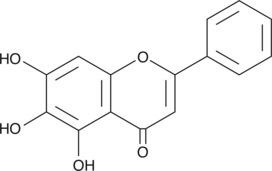Chemicals
Showing 10801–10950 of 41137 results
-
B-RAF IN 1 is an inhibitor of B-RAF (IC50 = 24 nM) that also inhibits C-RAF (IC50 = 25 nM).{41136} It is selective over 13 other kinases, including PKCα, IKKβ, and PI3Kα, at concentrations greater than 2 µM, but does inhibit p38α and CAMKII (IC50s = 216 and 822 nM, respectively). B-RAF IN 1 binds to B-RAF in the inactive conformation based on co-crystallization with the wild-type enzyme. It inhibits proliferation of WM 266-4 and HT29 cells with IC50 values of 920 and 780 nM, respectively.
Brand:CaymanSKU:23434 - 5 mgAvailable on backorder
B-RAF inhibitor 1 is an inhibitor of Raf kinases (Kis = 0.3, 1, and 1 nM for C-RAF, B-RAF, and B-RAFV600E, respectively).{45545} It is selective for the B-RAFV600E kinase domain over Lck, Tie2, KDR, and p38α (IC50s = 83, 120, 1,000, and >1,600 nM, respectively).{45546} B-RAF inhibitor 1 inhibits phosphorylation of ERK in A375 melanoma cells (IC50 = 1.8 nM). It reduces tumor growth in an A375 SQ2 mouse xenograft model (ED50 = 1.3 mg/kg per day) and induces 85% tumor regression when administered at a dose of 5 mg/kg per day for 14 days. B-RAF inhibitor 1 (5 and 10 mg/kg per day) increases tumor growth in a MIA PaCa-2 mouse xenograft model.{45545}
Brand:CaymanSKU:26792 - 1 mgAvailable on backorder
B-RAF inhibitor 1 is an inhibitor of Raf kinases (Kis = 0.3, 1, and 1 nM for C-RAF, B-RAF, and B-RAFV600E, respectively).{45545} It is selective for the B-RAFV600E kinase domain over Lck, Tie2, KDR, and p38α (IC50s = 83, 120, 1,000, and >1,600 nM, respectively).{45546} B-RAF inhibitor 1 inhibits phosphorylation of ERK in A375 melanoma cells (IC50 = 1.8 nM). It reduces tumor growth in an A375 SQ2 mouse xenograft model (ED50 = 1.3 mg/kg per day) and induces 85% tumor regression when administered at a dose of 5 mg/kg per day for 14 days. B-RAF inhibitor 1 (5 and 10 mg/kg per day) increases tumor growth in a MIA PaCa-2 mouse xenograft model.{45545}
Brand:CaymanSKU:26792 - 10 mgAvailable on backorder
B-RAF inhibitor 1 is an inhibitor of Raf kinases (Kis = 0.3, 1, and 1 nM for C-RAF, B-RAF, and B-RAFV600E, respectively).{45545} It is selective for the B-RAFV600E kinase domain over Lck, Tie2, KDR, and p38α (IC50s = 83, 120, 1,000, and >1,600 nM, respectively).{45546} B-RAF inhibitor 1 inhibits phosphorylation of ERK in A375 melanoma cells (IC50 = 1.8 nM). It reduces tumor growth in an A375 SQ2 mouse xenograft model (ED50 = 1.3 mg/kg per day) and induces 85% tumor regression when administered at a dose of 5 mg/kg per day for 14 days. B-RAF inhibitor 1 (5 and 10 mg/kg per day) increases tumor growth in a MIA PaCa-2 mouse xenograft model.{45545}
Brand:CaymanSKU:26792 - 25 mgAvailable on backorder
B-RAF inhibitor 1 is an inhibitor of Raf kinases (Kis = 0.3, 1, and 1 nM for C-RAF, B-RAF, and B-RAFV600E, respectively).{45545} It is selective for the B-RAFV600E kinase domain over Lck, Tie2, KDR, and p38α (IC50s = 83, 120, 1,000, and >1,600 nM, respectively).{45546} B-RAF inhibitor 1 inhibits phosphorylation of ERK in A375 melanoma cells (IC50 = 1.8 nM). It reduces tumor growth in an A375 SQ2 mouse xenograft model (ED50 = 1.3 mg/kg per day) and induces 85% tumor regression when administered at a dose of 5 mg/kg per day for 14 days. B-RAF inhibitor 1 (5 and 10 mg/kg per day) increases tumor growth in a MIA PaCa-2 mouse xenograft model.{45545}
Brand:CaymanSKU:26792 - 5 mgAvailable on backorder
B355252 is a neuroprotective agent.{52030,52031,52032} It potentiates NGF-induced neurite outgrowth in NS-1 cells (EC50 = ~1 μM).{52030} B355252 inhibits glutamate-induced excitotoxicity in HT-22 cells in a concentration-dependent manner and inhibits glutamate-induced decreases in GSH levels and increases in Bax levels, intracellular accumulation of calcium, and production of reactive oxygen species (ROS) in HT-22 cells when used at a concentration of 8 μM.{52031} It also inhibits decreases in cell viability, increases in ROS production, and mitochondrial membrane depolarization induced by 6-hydroxydopamine (6-OHDA; Item No. 25330) in HT-22 cells, an in vitro model of Parkinson’s disease.{52032}
Brand:CaymanSKU:21550 -Out of stock
B355252 is a neuroprotective agent.{52030,52031,52032} It potentiates NGF-induced neurite outgrowth in NS-1 cells (EC50 = ~1 μM).{52030} B355252 inhibits glutamate-induced excitotoxicity in HT-22 cells in a concentration-dependent manner and inhibits glutamate-induced decreases in GSH levels and increases in Bax levels, intracellular accumulation of calcium, and production of reactive oxygen species (ROS) in HT-22 cells when used at a concentration of 8 μM.{52031} It also inhibits decreases in cell viability, increases in ROS production, and mitochondrial membrane depolarization induced by 6-hydroxydopamine (6-OHDA; Item No. 25330) in HT-22 cells, an in vitro model of Parkinson’s disease.{52032}
Brand:CaymanSKU:21550 -Out of stock
B355252 is a neuroprotective agent.{52030,52031,52032} It potentiates NGF-induced neurite outgrowth in NS-1 cells (EC50 = ~1 μM).{52030} B355252 inhibits glutamate-induced excitotoxicity in HT-22 cells in a concentration-dependent manner and inhibits glutamate-induced decreases in GSH levels and increases in Bax levels, intracellular accumulation of calcium, and production of reactive oxygen species (ROS) in HT-22 cells when used at a concentration of 8 μM.{52031} It also inhibits decreases in cell viability, increases in ROS production, and mitochondrial membrane depolarization induced by 6-hydroxydopamine (6-OHDA; Item No. 25330) in HT-22 cells, an in vitro model of Parkinson’s disease.{52032}
Brand:CaymanSKU:21550 -Out of stock
B355252 is a neuroprotective agent.{52030,52031,52032} It potentiates NGF-induced neurite outgrowth in NS-1 cells (EC50 = ~1 μM).{52030} B355252 inhibits glutamate-induced excitotoxicity in HT-22 cells in a concentration-dependent manner and inhibits glutamate-induced decreases in GSH levels and increases in Bax levels, intracellular accumulation of calcium, and production of reactive oxygen species (ROS) in HT-22 cells when used at a concentration of 8 μM.{52031} It also inhibits decreases in cell viability, increases in ROS production, and mitochondrial membrane depolarization induced by 6-hydroxydopamine (6-OHDA; Item No. 25330) in HT-22 cells, an in vitro model of Parkinson’s disease.{52032}
Brand:CaymanSKU:21550 -Out of stock
Baccatin III is a polycyclic diterpene originally isolated from the yew tree (Taxus) that is a precursor of paclitaxel (Item No. 10461).{37435,37436} Baccatin III induces apoptosis in JR4-Jurkat leukemia, HepG2 liver hepatocellular carcinoma, HeLa cervical, OVCAR-3 ovarian carcinoma, and T47D breast cancer cell lines (IC50s = 3.5, 3, 4, 5, and 2 μM, respectively).{37437} It dose-dependently increases the antigen presenting cell (APC) capacity of bone marrow-derived dendritic cells (BM-DCs) sensitized to OVA peptide but does not affect their phagocytic activity.{37438} Baccatin III (0.5 mg/kg per day) decreases tumor growth of 4T1 mammary carcinoma and CT26 colon carcinoma flank implants by 65.6 and 63.9%, respectively, as well as inhibits the accumulation and activity of myeloid-derived suppressor cells (MDSCs) in spleen in immunocompetent mice.{37439}
Brand:CaymanSKU:21404 -Out of stock
Baccatin III is a polycyclic diterpene originally isolated from the yew tree (Taxus) that is a precursor of paclitaxel (Item No. 10461).{37435,37436} Baccatin III induces apoptosis in JR4-Jurkat leukemia, HepG2 liver hepatocellular carcinoma, HeLa cervical, OVCAR-3 ovarian carcinoma, and T47D breast cancer cell lines (IC50s = 3.5, 3, 4, 5, and 2 μM, respectively).{37437} It dose-dependently increases the antigen presenting cell (APC) capacity of bone marrow-derived dendritic cells (BM-DCs) sensitized to OVA peptide but does not affect their phagocytic activity.{37438} Baccatin III (0.5 mg/kg per day) decreases tumor growth of 4T1 mammary carcinoma and CT26 colon carcinoma flank implants by 65.6 and 63.9%, respectively, as well as inhibits the accumulation and activity of myeloid-derived suppressor cells (MDSCs) in spleen in immunocompetent mice.{37439}
Brand:CaymanSKU:21404 -Out of stock
Baccatin III is a polycyclic diterpene originally isolated from the yew tree (Taxus) that is a precursor of paclitaxel (Item No. 10461).{37435,37436} Baccatin III induces apoptosis in JR4-Jurkat leukemia, HepG2 liver hepatocellular carcinoma, HeLa cervical, OVCAR-3 ovarian carcinoma, and T47D breast cancer cell lines (IC50s = 3.5, 3, 4, 5, and 2 μM, respectively).{37437} It dose-dependently increases the antigen presenting cell (APC) capacity of bone marrow-derived dendritic cells (BM-DCs) sensitized to OVA peptide but does not affect their phagocytic activity.{37438} Baccatin III (0.5 mg/kg per day) decreases tumor growth of 4T1 mammary carcinoma and CT26 colon carcinoma flank implants by 65.6 and 63.9%, respectively, as well as inhibits the accumulation and activity of myeloid-derived suppressor cells (MDSCs) in spleen in immunocompetent mice.{37439}
Brand:CaymanSKU:21404 -Out of stock
Baccatin III is a polycyclic diterpene originally isolated from the yew tree (Taxus) that is a precursor of paclitaxel (Item No. 10461).{37435,37436} Baccatin III induces apoptosis in JR4-Jurkat leukemia, HepG2 liver hepatocellular carcinoma, HeLa cervical, OVCAR-3 ovarian carcinoma, and T47D breast cancer cell lines (IC50s = 3.5, 3, 4, 5, and 2 μM, respectively).{37437} It dose-dependently increases the antigen presenting cell (APC) capacity of bone marrow-derived dendritic cells (BM-DCs) sensitized to OVA peptide but does not affect their phagocytic activity.{37438} Baccatin III (0.5 mg/kg per day) decreases tumor growth of 4T1 mammary carcinoma and CT26 colon carcinoma flank implants by 65.6 and 63.9%, respectively, as well as inhibits the accumulation and activity of myeloid-derived suppressor cells (MDSCs) in spleen in immunocompetent mice.{37439}
Brand:CaymanSKU:21404 -Out of stock
Bacillosporin C is an oxaphenalenone dimer originally isolated from T. bacillosporus.{35181} Bacillosporin C, an anhydride, is formed from the lactone bacillosporin D in the mangrove endophytic fungus SBE-14.{35204} Similar oxaphenalenone dimers have antibiotic activity and inhibit acetylcholinesterase.{35213}
Brand:CaymanSKU:23877 - 1 mgAvailable on backorder
Bacillosporin C is an oxaphenalenone dimer originally isolated from T. bacillosporus.{35181} Bacillosporin C, an anhydride, is formed from the lactone bacillosporin D in the mangrove endophytic fungus SBE-14.{35204} Similar oxaphenalenone dimers have antibiotic activity and inhibit acetylcholinesterase.{35213}
Brand:CaymanSKU:23877 - 5 mgAvailable on backorder
Bacitracin is a cyclic polypeptide antibiotic that was first isolated from B. licheniformis.{33333} Formulations containing bacitracin, often combined with other antibiotics, are used for topical treatment of infections in humans and animals.{33331,33332} The activity of bacitracin can be enhanced by zinc.{33330} Bacitracin sequesters C55-isopropyl pyrophosphate (IPP), a lipid carrier in peptidoglycan synthesis, and in this way disrupts cell wall biosynthesis.{33331,33332}
Brand:CaymanSKU:21212 -Out of stock
Bacitracin is a cyclic polypeptide antibiotic that was first isolated from B. licheniformis.{33333} Formulations containing bacitracin, often combined with other antibiotics, are used for topical treatment of infections in humans and animals.{33331,33332} The activity of bacitracin can be enhanced by zinc.{33330} Bacitracin sequesters C55-isopropyl pyrophosphate (IPP), a lipid carrier in peptidoglycan synthesis, and in this way disrupts cell wall biosynthesis.{33331,33332}
Brand:CaymanSKU:21212 -Out of stock
Bacitracin is a cyclic polypeptide antibiotic that was first isolated from B. licheniformis.{33333} Formulations containing bacitracin, often combined with other antibiotics, are used for topical treatment of infections in humans and animals.{33331,33332} The activity of bacitracin can be enhanced by zinc.{33330} Bacitracin sequesters C55-isopropyl pyrophosphate (IPP), a lipid carrier in peptidoglycan synthesis, and in this way disrupts cell wall biosynthesis.{33331,33332}
Brand:CaymanSKU:21212 -Out of stock
Bacitracin is a cyclic polypeptide antibiotic that was first isolated from B. licheniformis.{33333} Formulations containing bacitracin, often combined with other antibiotics, are used for topical treatment of infections in humans and animals.{33331,33332} The activity of bacitracin can be enhanced by zinc.{33330} Bacitracin sequesters C55-isopropyl pyrophosphate (IPP), a lipid carrier in peptidoglycan synthesis, and in this way disrupts cell wall biosynthesis.{33331,33332}
Brand:CaymanSKU:21212 -Out of stock
Bacopasaponin C is a triterpenoid saponin originally isolated from B. monniera that has diverse biological activities.{48521,48522,48523} It inhibits the ATPase activity of P-glycoprotein (IC50 = 57.83 µg/ml).{39064} Bacopasaponin C inhibits scopolamine-induced impairments in spatial memory in the Morris water maze and memory retrieval in the step-down test in mice when administered at a dose of 50 mg/kg.{48521} It also decreases the time mice spent immobile in the forced swim and tail suspension tests, indicating antidepressant-like activity.{48522} Bacopasaponin C reduces the spleen parasite load in a hamster model of leishmaniasis when administered as a free compound or in liposomal, niosomal, microencapsulated, or nanocapsulated forms.{48523}
Brand:CaymanSKU:11820 - 1 mgAvailable on backorder
Bacopasaponin C is a triterpenoid saponin originally isolated from B. monniera that has diverse biological activities.{48521,48522,48523} It inhibits the ATPase activity of P-glycoprotein (IC50 = 57.83 µg/ml).{39064} Bacopasaponin C inhibits scopolamine-induced impairments in spatial memory in the Morris water maze and memory retrieval in the step-down test in mice when administered at a dose of 50 mg/kg.{48521} It also decreases the time mice spent immobile in the forced swim and tail suspension tests, indicating antidepressant-like activity.{48522} Bacopasaponin C reduces the spleen parasite load in a hamster model of leishmaniasis when administered as a free compound or in liposomal, niosomal, microencapsulated, or nanocapsulated forms.{48523}
Brand:CaymanSKU:11820 - 10 mgAvailable on backorder
Bacopasaponin C is a triterpenoid saponin originally isolated from B. monniera that has diverse biological activities.{48521,48522,48523} It inhibits the ATPase activity of P-glycoprotein (IC50 = 57.83 µg/ml).{39064} Bacopasaponin C inhibits scopolamine-induced impairments in spatial memory in the Morris water maze and memory retrieval in the step-down test in mice when administered at a dose of 50 mg/kg.{48521} It also decreases the time mice spent immobile in the forced swim and tail suspension tests, indicating antidepressant-like activity.{48522} Bacopasaponin C reduces the spleen parasite load in a hamster model of leishmaniasis when administered as a free compound or in liposomal, niosomal, microencapsulated, or nanocapsulated forms.{48523}
Brand:CaymanSKU:11820 - 25 mgAvailable on backorder
Bacopasaponin C is a triterpenoid saponin originally isolated from B. monniera that has diverse biological activities.{48521,48522,48523} It inhibits the ATPase activity of P-glycoprotein (IC50 = 57.83 µg/ml).{39064} Bacopasaponin C inhibits scopolamine-induced impairments in spatial memory in the Morris water maze and memory retrieval in the step-down test in mice when administered at a dose of 50 mg/kg.{48521} It also decreases the time mice spent immobile in the forced swim and tail suspension tests, indicating antidepressant-like activity.{48522} Bacopasaponin C reduces the spleen parasite load in a hamster model of leishmaniasis when administered as a free compound or in liposomal, niosomal, microencapsulated, or nanocapsulated forms.{48523}
Brand:CaymanSKU:11820 - 5 mgAvailable on backorder
Bacopaside I is a saponin that has been found in B. monniera and has diverse biological activities.{52632,52633,52635,52636} It inhibits monoamine oxidase A (MAO-A) and MAO-B (IC50s = 17.08 and 94.22 µg/ml, respectively).{52632} Bacopaside I (5, 15, and 50 mg/kg) decreases immobility time in the tail suspension and forced swim tests, as well as brain malondialdehyde (MDA) levels, and increases brain superoxide dismutase (SOD) and glutathione peroxidase (GPX) activities in mice.{52633} It increases time spent in the target quadrant in the Morris water maze and reduces amyloid plaque formation in the APP/PS1 transgenic mouse model of Alzheimer’s disease.{52635} Bacopaside I (3, 10, and 30 mg/kg) reduces cerebral edema and infarct volume in a rat model of transient focal ischemia induced by middle cerebral artery occlusion.{52636}
Brand:CaymanSKU:11821 - 1 mgAvailable on backorder
Bacopaside I is a saponin that has been found in B. monniera and has diverse biological activities.{52632,52633,52635,52636} It inhibits monoamine oxidase A (MAO-A) and MAO-B (IC50s = 17.08 and 94.22 µg/ml, respectively).{52632} Bacopaside I (5, 15, and 50 mg/kg) decreases immobility time in the tail suspension and forced swim tests, as well as brain malondialdehyde (MDA) levels, and increases brain superoxide dismutase (SOD) and glutathione peroxidase (GPX) activities in mice.{52633} It increases time spent in the target quadrant in the Morris water maze and reduces amyloid plaque formation in the APP/PS1 transgenic mouse model of Alzheimer’s disease.{52635} Bacopaside I (3, 10, and 30 mg/kg) reduces cerebral edema and infarct volume in a rat model of transient focal ischemia induced by middle cerebral artery occlusion.{52636}
Brand:CaymanSKU:11821 - 10 mgAvailable on backorder
Bacopaside I is a saponin that has been found in B. monniera and has diverse biological activities.{52632,52633,52635,52636} It inhibits monoamine oxidase A (MAO-A) and MAO-B (IC50s = 17.08 and 94.22 µg/ml, respectively).{52632} Bacopaside I (5, 15, and 50 mg/kg) decreases immobility time in the tail suspension and forced swim tests, as well as brain malondialdehyde (MDA) levels, and increases brain superoxide dismutase (SOD) and glutathione peroxidase (GPX) activities in mice.{52633} It increases time spent in the target quadrant in the Morris water maze and reduces amyloid plaque formation in the APP/PS1 transgenic mouse model of Alzheimer’s disease.{52635} Bacopaside I (3, 10, and 30 mg/kg) reduces cerebral edema and infarct volume in a rat model of transient focal ischemia induced by middle cerebral artery occlusion.{52636}
Brand:CaymanSKU:11821 - 5 mgAvailable on backorder
Bacopaside II is a triterpene glycoside found in B. monnieri that has neuroprotective, anti-angiogenic, and anticancer activities.{46392,48522,46393,46395} Bacopaside II (0.4 mg/ml) decreases hydrogen peroxide-induced intracellular reactive oxygen species (ROS) production and cell death in N2a neuroblastoma cells.{46392} It decreases immobility time in the forced swim and tail suspension tests in mice, indicating anti-depressant like activity, when administered at a dose of 50 mg/kg.{48522} Bacopaside II decreases migration and tube formation in 2H11 and 3B11 cells, as well as human umbilical vein endothelial cells (HUVECs) when used at concentrations greater than 15 µM.{46393} Bacopaside II inhibits the growth of MDA-MB-231, SHG-44, HCT8, A549, and PC3M cancer cells (IC50s = 32.4, 36.9, 40.3, 44.4, and 45.4 µM, respectively).{46395}
Brand:CaymanSKU:11822 - 1 mgAvailable on backorder
Bacopaside II is a triterpene glycoside found in B. monnieri that has neuroprotective, anti-angiogenic, and anticancer activities.{46392,48522,46393,46395} Bacopaside II (0.4 mg/ml) decreases hydrogen peroxide-induced intracellular reactive oxygen species (ROS) production and cell death in N2a neuroblastoma cells.{46392} It decreases immobility time in the forced swim and tail suspension tests in mice, indicating anti-depressant like activity, when administered at a dose of 50 mg/kg.{48522} Bacopaside II decreases migration and tube formation in 2H11 and 3B11 cells, as well as human umbilical vein endothelial cells (HUVECs) when used at concentrations greater than 15 µM.{46393} Bacopaside II inhibits the growth of MDA-MB-231, SHG-44, HCT8, A549, and PC3M cancer cells (IC50s = 32.4, 36.9, 40.3, 44.4, and 45.4 µM, respectively).{46395}
Brand:CaymanSKU:11822 - 10 mgAvailable on backorder
Bacopaside II is a triterpene glycoside found in B. monnieri that has neuroprotective, anti-angiogenic, and anticancer activities.{46392,48522,46393,46395} Bacopaside II (0.4 mg/ml) decreases hydrogen peroxide-induced intracellular reactive oxygen species (ROS) production and cell death in N2a neuroblastoma cells.{46392} It decreases immobility time in the forced swim and tail suspension tests in mice, indicating anti-depressant like activity, when administered at a dose of 50 mg/kg.{48522} Bacopaside II decreases migration and tube formation in 2H11 and 3B11 cells, as well as human umbilical vein endothelial cells (HUVECs) when used at concentrations greater than 15 µM.{46393} Bacopaside II inhibits the growth of MDA-MB-231, SHG-44, HCT8, A549, and PC3M cancer cells (IC50s = 32.4, 36.9, 40.3, 44.4, and 45.4 µM, respectively).{46395}
Brand:CaymanSKU:11822 - 5 mgAvailable on backorder
Bacopaside X is a triterpenoid saponin that has been found in B. monniera and has antifungal and anticancer activities.{48522,48711,46395} It inhibits the growth of the fungi C. albicans, C. neoformans, and A. fumigatus (MIC = 50 µg/ml for all).{48711} Bacopaside X decreases the proliferation of MDA-MB-231, SHG44, HCT8, A549, and PC3M cancer cell lines with IC50 values of 14.3, 15.9, 9.8, 9.7, and 10.1 µM, respectively.{46395} It reduces tumor growth by 84.13% in an S180 sarcoma mouse allograft model when administered at a dose of 50 µmol/kg.
Brand:CaymanSKU:11851 - 1 mgAvailable on backorder
Bacopaside X is a triterpenoid saponin that has been found in B. monniera and has antifungal and anticancer activities.{48522,48711,46395} It inhibits the growth of the fungi C. albicans, C. neoformans, and A. fumigatus (MIC = 50 µg/ml for all).{48711} Bacopaside X decreases the proliferation of MDA-MB-231, SHG44, HCT8, A549, and PC3M cancer cell lines with IC50 values of 14.3, 15.9, 9.8, 9.7, and 10.1 µM, respectively.{46395} It reduces tumor growth by 84.13% in an S180 sarcoma mouse allograft model when administered at a dose of 50 µmol/kg.
Brand:CaymanSKU:11851 - 10 mgAvailable on backorder
Bacopaside X is a triterpenoid saponin that has been found in B. monniera and has antifungal and anticancer activities.{48522,48711,46395} It inhibits the growth of the fungi C. albicans, C. neoformans, and A. fumigatus (MIC = 50 µg/ml for all).{48711} Bacopaside X decreases the proliferation of MDA-MB-231, SHG44, HCT8, A549, and PC3M cancer cell lines with IC50 values of 14.3, 15.9, 9.8, 9.7, and 10.1 µM, respectively.{46395} It reduces tumor growth by 84.13% in an S180 sarcoma mouse allograft model when administered at a dose of 50 µmol/kg.
Brand:CaymanSKU:11851 - 25 mgAvailable on backorder
Bacopaside X is a triterpenoid saponin that has been found in B. monniera and has antifungal and anticancer activities.{48522,48711,46395} It inhibits the growth of the fungi C. albicans, C. neoformans, and A. fumigatus (MIC = 50 µg/ml for all).{48711} Bacopaside X decreases the proliferation of MDA-MB-231, SHG44, HCT8, A549, and PC3M cancer cell lines with IC50 values of 14.3, 15.9, 9.8, 9.7, and 10.1 µM, respectively.{46395} It reduces tumor growth by 84.13% in an S180 sarcoma mouse allograft model when administered at a dose of 50 µmol/kg.
Brand:CaymanSKU:11851 - 5 mgAvailable on backorder
Bacoside A3 is a triterpenoid saponin first isolated from B. monniera.{39061} Bacoside A3 inhibits the ATP-binding cassette transporter P-glycoprotein (P-gp), decreasing efflux 4-fold compared with control in vitro.{39064} An extract containing bacoside A3 and bacopaside II (4 and 1.3 µg/mg extract, respectively) administered for eight days at a dose of 10-30 mg/kg reduces opioid withdrawal-induced depression in mice using the forced swim test.{39062} Bacoside A3 also has antioxidant properties following liver and kidney damage induced by street heroin in rats.{39063}
Brand:CaymanSKU:11824 - 5 mgAvailable on backorder
PPARγ is a ligand-activated transcription factor involved in the regulation of lipid homeostasis and may function as a master regulator of adipogenesis.{6619,2160,6620,4136} Ligands for PPARγ include antidiabetic drugs of the thiazolidinedione structural class, 15-deoxy-Δ12,14-prostaglandin J2, and NSAIDS.{8461,7575,1424,4044} BADGE is a synthetic compound used in the production of polycarbonate and industrial plastics. This compound was recently identified as an antagonist of PPARγ.{8241} BADGE binds to PPARγ with an apparent Kd of 100 µM and interferes with the ability of 3T3-L1 and 3T3-F442A cells to undergo hormone-mediated cell differentiation.{8241}
Brand:CaymanSKU:70790 - 100 gAvailable on backorder
PPARγ is a ligand-activated transcription factor involved in the regulation of lipid homeostasis and may function as a master regulator of adipogenesis.{6619,2160,6620,4136} Ligands for PPARγ include antidiabetic drugs of the thiazolidinedione structural class, 15-deoxy-Δ12,14-prostaglandin J2, and NSAIDS.{8461,7575,1424,4044} BADGE is a synthetic compound used in the production of polycarbonate and industrial plastics. This compound was recently identified as an antagonist of PPARγ.{8241} BADGE binds to PPARγ with an apparent Kd of 100 µM and interferes with the ability of 3T3-L1 and 3T3-F442A cells to undergo hormone-mediated cell differentiation.{8241}
Brand:CaymanSKU:70790 - 25 gAvailable on backorder
PPARγ is a ligand-activated transcription factor involved in the regulation of lipid homeostasis and may function as a master regulator of adipogenesis.{6619,2160,6620,4136} Ligands for PPARγ include antidiabetic drugs of the thiazolidinedione structural class, 15-deoxy-Δ12,14-prostaglandin J2, and NSAIDS.{8461,7575,1424,4044} BADGE is a synthetic compound used in the production of polycarbonate and industrial plastics. This compound was recently identified as an antagonist of PPARγ.{8241} BADGE binds to PPARγ with an apparent Kd of 100 µM and interferes with the ability of 3T3-L1 and 3T3-F442A cells to undergo hormone-mediated cell differentiation.{8241}
Brand:CaymanSKU:70790 - 50 gAvailable on backorder
PPARγ is a ligand-activated transcription factor involved in the regulation of lipid homeostasis and may function as a master regulator of adipogenesis.{6619,2160,6620,4136} Ligands for PPARγ include antidiabetic drugs of the thiazolidinedione structural class, 15-deoxy-Δ12,14-prostaglandin J2, and NSAIDS.{8461,7575,1424,4044} BADGE is a synthetic compound used in the production of polycarbonate and industrial plastics. This compound was recently identified as an antagonist of PPARγ.{8241} BADGE binds to PPARγ with an apparent Kd of 100 µM and interferes with the ability of 3T3-L1 and 3T3-F442A cells to undergo hormone-mediated cell differentiation.{8241}
Brand:CaymanSKU:70790 - 500 gAvailable on backorder
Bcr-Abl, a fusion protein with deregulated tyrosine kinase activity, is highly expressed in chronic myelogenous leukemia (CML). Bafetinib is a rationally developed tyrosine kinase inhibitor based on the chemical structure of imatinib (Item No. 13139), with modifications added to improve binding and potency against Bcr-Abl kinase (IC50 = 5.8 nM).{30982} It is 25- to 55-fold more potent than imatinib in vitro and ≥10-fold more potent in vivo.{30982} Bafetinib inhibits 12 out of the 13 most frequent imatinib-resistant Bcr-Abl point mutations, but not the T315I mutation and also targets the Src family kinase Lyn (IC50 = 19 nM), which has been associated with resistance to imatinib in CML.{30982}
Brand:CaymanSKU:-Available on backorder
Bcr-Abl, a fusion protein with deregulated tyrosine kinase activity, is highly expressed in chronic myelogenous leukemia (CML). Bafetinib is a rationally developed tyrosine kinase inhibitor based on the chemical structure of imatinib (Item No. 13139), with modifications added to improve binding and potency against Bcr-Abl kinase (IC50 = 5.8 nM).{30982} It is 25- to 55-fold more potent than imatinib in vitro and ≥10-fold more potent in vivo.{30982} Bafetinib inhibits 12 out of the 13 most frequent imatinib-resistant Bcr-Abl point mutations, but not the T315I mutation and also targets the Src family kinase Lyn (IC50 = 19 nM), which has been associated with resistance to imatinib in CML.{30982}
Brand:CaymanSKU:-Available on backorder
Bcr-Abl, a fusion protein with deregulated tyrosine kinase activity, is highly expressed in chronic myelogenous leukemia (CML). Bafetinib is a rationally developed tyrosine kinase inhibitor based on the chemical structure of imatinib (Item No. 13139), with modifications added to improve binding and potency against Bcr-Abl kinase (IC50 = 5.8 nM).{30982} It is 25- to 55-fold more potent than imatinib in vitro and ≥10-fold more potent in vivo.{30982} Bafetinib inhibits 12 out of the 13 most frequent imatinib-resistant Bcr-Abl point mutations, but not the T315I mutation and also targets the Src family kinase Lyn (IC50 = 19 nM), which has been associated with resistance to imatinib in CML.{30982}
Brand:CaymanSKU:-Available on backorder
Bafilomycin A1 is a selective, reversible inhibitor of vacuolar H+-ATPases (V-ATPases), blocking these proton pumps in mammalian, plant, or fungal cells with an IC50 value in the 4-400 nM range.{20718} It is at least 1,000-fold less potent at most other types of ATPases.{20718} Bafilomycin A1 also inhibits autophagy by preventing vacuolar acidification necessary for autophagosome maturation.{20721,20720}
Brand:CaymanSKU:11038 - 1 mgAvailable on backorder
Bafilomycin A1 is a selective, reversible inhibitor of vacuolar H+-ATPases (V-ATPases), blocking these proton pumps in mammalian, plant, or fungal cells with an IC50 value in the 4-400 nM range.{20718} It is at least 1,000-fold less potent at most other types of ATPases.{20718} Bafilomycin A1 also inhibits autophagy by preventing vacuolar acidification necessary for autophagosome maturation.{20721,20720}
Brand:CaymanSKU:11038 - 5 mgAvailable on backorder
Bafilomycin A1 is a selective, reversible inhibitor of vacuolar H+-ATPases (V-ATPases), blocking these proton pumps in mammalian, plant, or fungal cells with an IC50 value in the 4-400 nM range.{20718} It is at least 1,000-fold less potent at most other types of ATPases.{20718} Bafilomycin A1 also inhibits autophagy by preventing vacuolar acidification necessary for autophagosome maturation.{20721,20720}
Brand:CaymanSKU:11038 - 500 µgAvailable on backorder
The bafilomycins are fungal plecomacrolide antibiotics with a 16-membered lactone ring. They inhibit the growth of Gram-positive bacteria and fungi.{20718} Bafilomycin B1 is a selective, reversible inhibitor of vacuolar H+-ATPases (V-ATPases), blocking these proton pumps in mammalian, plant, or fungal cells with an IC50 value in the 4-400 nM range.{20718} It is at least 1,000-fold less potent at most other types of ATPases.{20718} When used at 100 nM, the related macrolide bafilomycin A1 blocks V-ATPase-mediated acidification of lysosomes during autophagy, preventing protein degradation.{20721} Remarkably, at only 1 nM, both bafilomycin A1 or B1 dramatically attenuate chloroquine-induced apoptosis of neurons without altering autophagy.{20720}
Brand:CaymanSKU:-The bafilomycins are fungal plecomacrolide antibiotics with a 16-membered lactone ring. They inhibit the growth of Gram-positive bacteria and fungi.{20718} Bafilomycin B1 is a selective, reversible inhibitor of vacuolar H+-ATPases (V-ATPases), blocking these proton pumps in mammalian, plant, or fungal cells with an IC50 value in the 4-400 nM range.{20718} It is at least 1,000-fold less potent at most other types of ATPases.{20718} When used at 100 nM, the related macrolide bafilomycin A1 blocks V-ATPase-mediated acidification of lysosomes during autophagy, preventing protein degradation.{20721} Remarkably, at only 1 nM, both bafilomycin A1 or B1 dramatically attenuate chloroquine-induced apoptosis of neurons without altering autophagy.{20720}
Brand:CaymanSKU:-The bafilomycins are fungal plecomacrolide antibiotics with a 16-membered lactone ring. They inhibit the growth of Gram-positive bacteria and fungi.{20718} Bafilomycin B1 is a selective, reversible inhibitor of vacuolar H+-ATPases (V-ATPases), blocking these proton pumps in mammalian, plant, or fungal cells with an IC50 value in the 4-400 nM range.{20718} It is at least 1,000-fold less potent at most other types of ATPases.{20718} When used at 100 nM, the related macrolide bafilomycin A1 blocks V-ATPase-mediated acidification of lysosomes during autophagy, preventing protein degradation.{20721} Remarkably, at only 1 nM, both bafilomycin A1 or B1 dramatically attenuate chloroquine-induced apoptosis of neurons without altering autophagy.{20720}
Brand:CaymanSKU:-Bafilomycin C1 is a selective, reversible inhibitor of vacuolar H+-ATPases (V-ATPases).{20718} It blocks these pumps in mammalian, plant, or fungal cells, preventing proton transport and compartment acidification.{20718} Bafilomycin C1 has been shown to have angiostatic activity in the chick chorioallantoic membrane assay.{31293} It has also been used, when coupled to cellulose, to purify V-ATPases.{31294}
Brand:CaymanSKU:19625 -Available on backorder
Bafilomycin C1 is a selective, reversible inhibitor of vacuolar H+-ATPases (V-ATPases).{20718} It blocks these pumps in mammalian, plant, or fungal cells, preventing proton transport and compartment acidification.{20718} Bafilomycin C1 has been shown to have angiostatic activity in the chick chorioallantoic membrane assay.{31293} It has also been used, when coupled to cellulose, to purify V-ATPases.{31294}
Brand:CaymanSKU:19625 -Available on backorder
The bafilomycins are fungal plecomacrolide antibiotics with a 16-membered lactone ring. They inhibit the growth of Gram-positive bacteria and fungi.{20718,20778} Bafilomycin D is a potent inhibitor of vacuolar H+ ATPases (V-ATPases) that inhibits the V-ATPase from the fungus N. crassa with an IC50 value of approximately 2 nM.{20778} It is about 1,000-fold less effective against the K+-dependent ATPase of E. coli.{20778}
Brand:CaymanSKU:-Available on backorder
The bafilomycins are fungal plecomacrolide antibiotics with a 16-membered lactone ring. They inhibit the growth of Gram-positive bacteria and fungi.{20718,20778} Bafilomycin D is a potent inhibitor of vacuolar H+ ATPases (V-ATPases) that inhibits the V-ATPase from the fungus N. crassa with an IC50 value of approximately 2 nM.{20778} It is about 1,000-fold less effective against the K+-dependent ATPase of E. coli.{20778}
Brand:CaymanSKU:-Available on backorder
Baicalein is a flavonoid originally isolated from the roots of S. baicalensis that has diverse biological activities.{37567} It inhibits human platelet 12-lipoxygenase (12-LO) and human reticulocyte 15-LO-1 (IC50s = 0.64 and 1.6 µM, respectively) but is less potent at 15-LO-1 when the detergent Triton-X is present (IC50 = 38 µM).{37568} Baicalein inhibits lipid peroxidation, as assessed by production of thiobarbituric acid (TBARS; IC50 = 5 µM), and inhibits growth of Huh-7, KIM-1, and HLF human hepatocellular carcinoma cells (IC50s = 17-70 µg/ml).{5688,5627} Baicalein increases intracellular calcium levels by increasing release from the endoplasmic reticulum and via PKC-dependent calcium channels in the plasma membrane, leading to increases in reactive oxygen species (ROS), caspase-9 and -3 activation, and apoptosis in ZR-75-1 human breast cancer cells.{37569} Baicalein increases levels of peroxisome proliferator-activated receptor β/δ (PPARβ/δ) in BV-2 microglia and primary microglia and decreases the level of 12- and 15-LO products.{37570} It also decreases symptoms of experimental autoimmune encephalomyelitis (EAE) in a mouse model of multiple sclerosis, when administered at a dose of 75 mg/kg per day.
Brand:CaymanSKU:70610 - 1 gAvailable on backorder
Baicalein is a flavonoid originally isolated from the roots of S. baicalensis that has diverse biological activities.{37567} It inhibits human platelet 12-lipoxygenase (12-LO) and human reticulocyte 15-LO-1 (IC50s = 0.64 and 1.6 µM, respectively) but is less potent at 15-LO-1 when the detergent Triton-X is present (IC50 = 38 µM).{37568} Baicalein inhibits lipid peroxidation, as assessed by production of thiobarbituric acid (TBARS; IC50 = 5 µM), and inhibits growth of Huh-7, KIM-1, and HLF human hepatocellular carcinoma cells (IC50s = 17-70 µg/ml).{5688,5627} Baicalein increases intracellular calcium levels by increasing release from the endoplasmic reticulum and via PKC-dependent calcium channels in the plasma membrane, leading to increases in reactive oxygen species (ROS), caspase-9 and -3 activation, and apoptosis in ZR-75-1 human breast cancer cells.{37569} Baicalein increases levels of peroxisome proliferator-activated receptor β/δ (PPARβ/δ) in BV-2 microglia and primary microglia and decreases the level of 12- and 15-LO products.{37570} It also decreases symptoms of experimental autoimmune encephalomyelitis (EAE) in a mouse model of multiple sclerosis, when administered at a dose of 75 mg/kg per day.
Brand:CaymanSKU:70610 - 100 mgAvailable on backorder
Baicalein is a flavonoid originally isolated from the roots of S. baicalensis that has diverse biological activities.{37567} It inhibits human platelet 12-lipoxygenase (12-LO) and human reticulocyte 15-LO-1 (IC50s = 0.64 and 1.6 µM, respectively) but is less potent at 15-LO-1 when the detergent Triton-X is present (IC50 = 38 µM).{37568} Baicalein inhibits lipid peroxidation, as assessed by production of thiobarbituric acid (TBARS; IC50 = 5 µM), and inhibits growth of Huh-7, KIM-1, and HLF human hepatocellular carcinoma cells (IC50s = 17-70 µg/ml).{5688,5627} Baicalein increases intracellular calcium levels by increasing release from the endoplasmic reticulum and via PKC-dependent calcium channels in the plasma membrane, leading to increases in reactive oxygen species (ROS), caspase-9 and -3 activation, and apoptosis in ZR-75-1 human breast cancer cells.{37569} Baicalein increases levels of peroxisome proliferator-activated receptor β/δ (PPARβ/δ) in BV-2 microglia and primary microglia and decreases the level of 12- and 15-LO products.{37570} It also decreases symptoms of experimental autoimmune encephalomyelitis (EAE) in a mouse model of multiple sclerosis, when administered at a dose of 75 mg/kg per day.
Brand:CaymanSKU:70610 - 50 mgAvailable on backorder
Baicalein is a flavonoid originally isolated from the roots of S. baicalensis that has diverse biological activities.{37567} It inhibits human platelet 12-lipoxygenase (12-LO) and human reticulocyte 15-LO-1 (IC50s = 0.64 and 1.6 µM, respectively) but is less potent at 15-LO-1 when the detergent Triton-X is present (IC50 = 38 µM).{37568} Baicalein inhibits lipid peroxidation, as assessed by production of thiobarbituric acid (TBARS; IC50 = 5 µM), and inhibits growth of Huh-7, KIM-1, and HLF human hepatocellular carcinoma cells (IC50s = 17-70 µg/ml).{5688,5627} Baicalein increases intracellular calcium levels by increasing release from the endoplasmic reticulum and via PKC-dependent calcium channels in the plasma membrane, leading to increases in reactive oxygen species (ROS), caspase-9 and -3 activation, and apoptosis in ZR-75-1 human breast cancer cells.{37569} Baicalein increases levels of peroxisome proliferator-activated receptor β/δ (PPARβ/δ) in BV-2 microglia and primary microglia and decreases the level of 12- and 15-LO products.{37570} It also decreases symptoms of experimental autoimmune encephalomyelitis (EAE) in a mouse model of multiple sclerosis, when administered at a dose of 75 mg/kg per day.
Brand:CaymanSKU:70610 - 500 mgAvailable on backorder
Baicalin is a flavonoid that has been found in S. baicalensis and has diverse biological activities.{53853,53854,53855,53857,53856} It reduces myocardial apoptosis and increases cardiac microvessel levels of endothelial nitric oxide synthase (eNOS) in a rat model of ischemia-reperfusion injury when administered at doses of 30 and 100 mg/kg. Baicalin (50 and 80 mg/kg) increases the number of intratumor CD8+ T cells and reduces tumor volume in an H22 murine hepatocellular carcinoma model.{53854} It reduces LPS-induced cortical production of reactive oxygen species (ROS) and levels of IL-1β and TNF-α in a mouse model of neuroinflammation.{53855} Baicalin decreases body weight, increases the number of rats with regular estrous cycles, and ameliorates follicular development in a mouse model of dehydroepiandrosterone-induced polycystic ovary syndrome (PCOS).{53857} It also decreases immobility time in the forced swim test in a mouse model of depression induced by chronic mild stress.{53856}
Brand:CaymanSKU:19843 -Available on backorder
Baicalin is a flavonoid that has been found in S. baicalensis and has diverse biological activities.{53853,53854,53855,53857,53856} It reduces myocardial apoptosis and increases cardiac microvessel levels of endothelial nitric oxide synthase (eNOS) in a rat model of ischemia-reperfusion injury when administered at doses of 30 and 100 mg/kg. Baicalin (50 and 80 mg/kg) increases the number of intratumor CD8+ T cells and reduces tumor volume in an H22 murine hepatocellular carcinoma model.{53854} It reduces LPS-induced cortical production of reactive oxygen species (ROS) and levels of IL-1β and TNF-α in a mouse model of neuroinflammation.{53855} Baicalin decreases body weight, increases the number of rats with regular estrous cycles, and ameliorates follicular development in a mouse model of dehydroepiandrosterone-induced polycystic ovary syndrome (PCOS).{53857} It also decreases immobility time in the forced swim test in a mouse model of depression induced by chronic mild stress.{53856}
Brand:CaymanSKU:19843 -Available on backorder
Baicalin is a flavonoid that has been found in S. baicalensis and has diverse biological activities.{53853,53854,53855,53857,53856} It reduces myocardial apoptosis and increases cardiac microvessel levels of endothelial nitric oxide synthase (eNOS) in a rat model of ischemia-reperfusion injury when administered at doses of 30 and 100 mg/kg. Baicalin (50 and 80 mg/kg) increases the number of intratumor CD8+ T cells and reduces tumor volume in an H22 murine hepatocellular carcinoma model.{53854} It reduces LPS-induced cortical production of reactive oxygen species (ROS) and levels of IL-1β and TNF-α in a mouse model of neuroinflammation.{53855} Baicalin decreases body weight, increases the number of rats with regular estrous cycles, and ameliorates follicular development in a mouse model of dehydroepiandrosterone-induced polycystic ovary syndrome (PCOS).{53857} It also decreases immobility time in the forced swim test in a mouse model of depression induced by chronic mild stress.{53856}
Brand:CaymanSKU:19843 -Available on backorder
Baicalin is a flavonoid that has been found in S. baicalensis and has diverse biological activities.{53853,53854,53855,53857,53856} It reduces myocardial apoptosis and increases cardiac microvessel levels of endothelial nitric oxide synthase (eNOS) in a rat model of ischemia-reperfusion injury when administered at doses of 30 and 100 mg/kg. Baicalin (50 and 80 mg/kg) increases the number of intratumor CD8+ T cells and reduces tumor volume in an H22 murine hepatocellular carcinoma model.{53854} It reduces LPS-induced cortical production of reactive oxygen species (ROS) and levels of IL-1β and TNF-α in a mouse model of neuroinflammation.{53855} Baicalin decreases body weight, increases the number of rats with regular estrous cycles, and ameliorates follicular development in a mouse model of dehydroepiandrosterone-induced polycystic ovary syndrome (PCOS).{53857} It also decreases immobility time in the forced swim test in a mouse model of depression induced by chronic mild stress.{53856}
Brand:CaymanSKU:19843 -Available on backorder
Bakuchiol is a natural meroterpene isolated from P. corylifolia, a plant used in traditional Asian medicine. In addition to having antioxidant and antibacterial actions, bakuchiol has retinol-like effects on gene expression and properties of the skin.{27738,27739,27737} Bakuchiol also inhibits DNA polymerase and UDP-glucuronosyltransferase 2B7 (IC50 = 41 µM).{21166,27736}
Brand:CaymanSKU:11684 - 10 mgAvailable on backorder
Bakuchiol is a natural meroterpene isolated from P. corylifolia, a plant used in traditional Asian medicine. In addition to having antioxidant and antibacterial actions, bakuchiol has retinol-like effects on gene expression and properties of the skin.{27738,27739,27737} Bakuchiol also inhibits DNA polymerase and UDP-glucuronosyltransferase 2B7 (IC50 = 41 µM).{21166,27736}
Brand:CaymanSKU:11684 - 25 mgAvailable on backorder
Bakuchiol is a natural meroterpene isolated from P. corylifolia, a plant used in traditional Asian medicine. In addition to having antioxidant and antibacterial actions, bakuchiol has retinol-like effects on gene expression and properties of the skin.{27738,27739,27737} Bakuchiol also inhibits DNA polymerase and UDP-glucuronosyltransferase 2B7 (IC50 = 41 µM).{21166,27736}
Brand:CaymanSKU:11684 - 5 mgAvailable on backorder
Bakuchiol is a natural meroterpene isolated from P. corylifolia, a plant used in traditional Asian medicine. In addition to having antioxidant and antibacterial actions, bakuchiol has retinol-like effects on gene expression and properties of the skin.{27738,27739,27737} Bakuchiol also inhibits DNA polymerase and UDP-glucuronosyltransferase 2B7 (IC50 = 41 µM).{21166,27736}
Brand:CaymanSKU:11684 - 50 mgAvailable on backorder
Balaglitazone is a partial agonist of peroxisome proliferator-activated receptor γ (PPARγ; EC50 = 1.351 μM in a transactivation assay).{48619} It decreases non-fasting plasma glucose levels in diabetic db/db mice (ED90 = 3 mg/kg per day). Balaglitazone (5 and 10 mg/kg per day) decreases plasma levels of insulin and glucose in an oral glucose tolerance test in diet-induced obese rats.{48620} In doxorubicin-resistant K562 human myelogenous leukemia cells, balaglitazone (25 μM) decreases P-glycoprotein (P-gp) levels, increases intracellular accumulation of the P-gp substrate rhodamine 123 (Item No. 16672), and sensitizes cells to doxorubicin (Item No. 15007).{48621}
Brand:CaymanSKU:28866 - 1 mgAvailable on backorder
Balaglitazone is a partial agonist of peroxisome proliferator-activated receptor γ (PPARγ; EC50 = 1.351 μM in a transactivation assay).{48619} It decreases non-fasting plasma glucose levels in diabetic db/db mice (ED90 = 3 mg/kg per day). Balaglitazone (5 and 10 mg/kg per day) decreases plasma levels of insulin and glucose in an oral glucose tolerance test in diet-induced obese rats.{48620} In doxorubicin-resistant K562 human myelogenous leukemia cells, balaglitazone (25 μM) decreases P-glycoprotein (P-gp) levels, increases intracellular accumulation of the P-gp substrate rhodamine 123 (Item No. 16672), and sensitizes cells to doxorubicin (Item No. 15007).{48621}
Brand:CaymanSKU:28866 - 10 mgAvailable on backorder
Balaglitazone is a partial agonist of peroxisome proliferator-activated receptor γ (PPARγ; EC50 = 1.351 μM in a transactivation assay).{48619} It decreases non-fasting plasma glucose levels in diabetic db/db mice (ED90 = 3 mg/kg per day). Balaglitazone (5 and 10 mg/kg per day) decreases plasma levels of insulin and glucose in an oral glucose tolerance test in diet-induced obese rats.{48620} In doxorubicin-resistant K562 human myelogenous leukemia cells, balaglitazone (25 μM) decreases P-glycoprotein (P-gp) levels, increases intracellular accumulation of the P-gp substrate rhodamine 123 (Item No. 16672), and sensitizes cells to doxorubicin (Item No. 15007).{48621}
Brand:CaymanSKU:28866 - 25 mgAvailable on backorder
Balaglitazone is a partial agonist of peroxisome proliferator-activated receptor γ (PPARγ; EC50 = 1.351 μM in a transactivation assay).{48619} It decreases non-fasting plasma glucose levels in diabetic db/db mice (ED90 = 3 mg/kg per day). Balaglitazone (5 and 10 mg/kg per day) decreases plasma levels of insulin and glucose in an oral glucose tolerance test in diet-induced obese rats.{48620} In doxorubicin-resistant K562 human myelogenous leukemia cells, balaglitazone (25 μM) decreases P-glycoprotein (P-gp) levels, increases intracellular accumulation of the P-gp substrate rhodamine 123 (Item No. 16672), and sensitizes cells to doxorubicin (Item No. 15007).{48621}
Brand:CaymanSKU:28866 - 5 mgAvailable on backorder
Balicatib is a potent inhibitor of cathepsin K (IC50s = 1.4, 56, and 480 nM for human, rat, and mouse forms, respectively).{32548,32549} it is at least 100-fold selective for cathepsin K over cathepsins B, L, and S.{32549} Balicatib has a basic lipophilic nature, resulting in lysosomal trapping and increased selectivity for lysosomal cathepsin K.{32548,32549}
Brand:CaymanSKU:-Available on backorder
Balicatib is a potent inhibitor of cathepsin K (IC50s = 1.4, 56, and 480 nM for human, rat, and mouse forms, respectively).{32548,32549} it is at least 100-fold selective for cathepsin K over cathepsins B, L, and S.{32549} Balicatib has a basic lipophilic nature, resulting in lysosomal trapping and increased selectivity for lysosomal cathepsin K.{32548,32549}
Brand:CaymanSKU:-Available on backorder
Balicatib is a potent inhibitor of cathepsin K (IC50s = 1.4, 56, and 480 nM for human, rat, and mouse forms, respectively).{32548,32549} it is at least 100-fold selective for cathepsin K over cathepsins B, L, and S.{32549} Balicatib has a basic lipophilic nature, resulting in lysosomal trapping and increased selectivity for lysosomal cathepsin K.{32548,32549}
Brand:CaymanSKU:-Available on backorder
Balicatib is a potent inhibitor of cathepsin K (IC50s = 1.4, 56, and 480 nM for human, rat, and mouse forms, respectively).{32548,32549} it is at least 100-fold selective for cathepsin K over cathepsins B, L, and S.{32549} Balicatib has a basic lipophilic nature, resulting in lysosomal trapping and increased selectivity for lysosomal cathepsin K.{32548,32549}
Brand:CaymanSKU:-Available on backorder
Balofloxacin is a fluoroquinolone antibiotic.{36836} It is active against clinical isolates of a variety of Gram-positive and Gram-negative bacteria in vitro, including K. pneumoniae, H. influenzae, N. gonorrhoeae, P. mirabilis, S. pyogenes, and methicillin-resistant S. aureus (MRSA; MIC50s = 0.025-0.78 μg/ml). Balofloxacin inhibits DNA gyrase from E. coli, P. aeruginosa, and S. aureus (IC50s = 0.47, 11, and 2.5 μg/ml, respectively, in a DNA supercoiling assay). It reduces mortality in mouse models of systemic S. aureus, MRSA, S. pneumoniae, K. pneumoniae, and P. aeruginosa infection (ED50s = 5, 20, 10, 160, and 50.4 mg/kg, respectively).{36837}
Brand:CaymanSKU:25504 - 1 gAvailable on backorder
Balofloxacin is a fluoroquinolone antibiotic.{36836} It is active against clinical isolates of a variety of Gram-positive and Gram-negative bacteria in vitro, including K. pneumoniae, H. influenzae, N. gonorrhoeae, P. mirabilis, S. pyogenes, and methicillin-resistant S. aureus (MRSA; MIC50s = 0.025-0.78 μg/ml). Balofloxacin inhibits DNA gyrase from E. coli, P. aeruginosa, and S. aureus (IC50s = 0.47, 11, and 2.5 μg/ml, respectively, in a DNA supercoiling assay). It reduces mortality in mouse models of systemic S. aureus, MRSA, S. pneumoniae, K. pneumoniae, and P. aeruginosa infection (ED50s = 5, 20, 10, 160, and 50.4 mg/kg, respectively).{36837}
Brand:CaymanSKU:25504 - 10 gAvailable on backorder
Balofloxacin is a fluoroquinolone antibiotic.{36836} It is active against clinical isolates of a variety of Gram-positive and Gram-negative bacteria in vitro, including K. pneumoniae, H. influenzae, N. gonorrhoeae, P. mirabilis, S. pyogenes, and methicillin-resistant S. aureus (MRSA; MIC50s = 0.025-0.78 μg/ml). Balofloxacin inhibits DNA gyrase from E. coli, P. aeruginosa, and S. aureus (IC50s = 0.47, 11, and 2.5 μg/ml, respectively, in a DNA supercoiling assay). It reduces mortality in mouse models of systemic S. aureus, MRSA, S. pneumoniae, K. pneumoniae, and P. aeruginosa infection (ED50s = 5, 20, 10, 160, and 50.4 mg/kg, respectively).{36837}
Brand:CaymanSKU:25504 - 5 gAvailable on backorder
Balofloxacin is a fluoroquinolone antibiotic.{36836} It is active against clinical isolates of a variety of Gram-positive and Gram-negative bacteria in vitro, including K. pneumoniae, H. influenzae, N. gonorrhoeae, P. mirabilis, S. pyogenes, and methicillin-resistant S. aureus (MRSA; MIC50s = 0.025-0.78 μg/ml). Balofloxacin inhibits DNA gyrase from E. coli, P. aeruginosa, and S. aureus (IC50s = 0.47, 11, and 2.5 μg/ml, respectively, in a DNA supercoiling assay). It reduces mortality in mouse models of systemic S. aureus, MRSA, S. pneumoniae, K. pneumoniae, and P. aeruginosa infection (ED50s = 5, 20, 10, 160, and 50.4 mg/kg, respectively).{36837}
Brand:CaymanSKU:25504 - 500 mgAvailable on backorder
Balsalazide is a prodrug form of 5-aminosalicylic acid (5-ASA; Item No. 70265).{48536} It is cleaved by bacterial azoreductases in the intestinal lumen to release 5-ASA. Balsalazide (600 mg/kg per day) decreases IL-2 levels and increases IL-6 levels in the serum and colonic mucosa membrane, as well as decreases micro- and macroscopic colonic damage, in a rat model of colitis induced by 2,4-dinitrochlorobenzene (DNCB).{48537} Formulations containing balsalazide have been used in the treatment of ulcerative colitis.
Brand:CaymanSKU:-Available on backorder
Balsalazide is a prodrug form of 5-aminosalicylic acid (5-ASA; Item No. 70265).{48536} It is cleaved by bacterial azoreductases in the intestinal lumen to release 5-ASA. Balsalazide (600 mg/kg per day) decreases IL-2 levels and increases IL-6 levels in the serum and colonic mucosa membrane, as well as decreases micro- and macroscopic colonic damage, in a rat model of colitis induced by 2,4-dinitrochlorobenzene (DNCB).{48537} Formulations containing balsalazide have been used in the treatment of ulcerative colitis.
Brand:CaymanSKU:-Available on backorder
Balsalazide is a prodrug form of 5-aminosalicylic acid (5-ASA; Item No. 70265).{48536} It is cleaved by bacterial azoreductases in the intestinal lumen to release 5-ASA. Balsalazide (600 mg/kg per day) decreases IL-2 levels and increases IL-6 levels in the serum and colonic mucosa membrane, as well as decreases micro- and macroscopic colonic damage, in a rat model of colitis induced by 2,4-dinitrochlorobenzene (DNCB).{48537} Formulations containing balsalazide have been used in the treatment of ulcerative colitis.
Brand:CaymanSKU:-Available on backorder
Balsalazide is a prodrug form of 5-aminosalicylic acid (5-ASA; Item No. 70265).{48536} It is cleaved by bacterial azoreductases in the intestinal lumen to release 5-ASA. Balsalazide (600 mg/kg per day) decreases IL-2 levels and increases IL-6 levels in the serum and colonic mucosa membrane, as well as decreases micro- and macroscopic colonic damage, in a rat model of colitis induced by 2,4-dinitrochlorobenzene (DNCB).{48537} Formulations containing balsalazide have been used in the treatment of ulcerative colitis.
Brand:CaymanSKU:-Available on backorder
Typical mitochondrial uncouplers are lipophilic weak acids that increase proton transport into the mitochondrial matrix through an ATP synthase-independent pathway, thereby uncoupling nutrient oxidation from ATP production. These chemicals are used to determine rate of cellular respiration and have antioxidant effects that protect from ischemia-reperfusion injury. Most proton transporter uncouplers, however, exhibit off-target activity that can lead to undesired effects, including plasma membrane depolarization, mitochondrial inhibition, and cytotoxicity. BAM15 is a mitochondrial protonophore uncoupler that does not depolarize the plasma membrane and protects mice from acute renal ischemic-reperfusion injury.{28818} In comparison to FCCP (Item No. 15218), 1-10 µM BAM15 was shown to increase oxygen flux with equal potency as the classic uncoupler, while displaying a higher maximum rate of mitochondrial respiration and less cytotoxicity.{28818}
Brand:CaymanSKU:-Available on backorder
Typical mitochondrial uncouplers are lipophilic weak acids that increase proton transport into the mitochondrial matrix through an ATP synthase-independent pathway, thereby uncoupling nutrient oxidation from ATP production. These chemicals are used to determine rate of cellular respiration and have antioxidant effects that protect from ischemia-reperfusion injury. Most proton transporter uncouplers, however, exhibit off-target activity that can lead to undesired effects, including plasma membrane depolarization, mitochondrial inhibition, and cytotoxicity. BAM15 is a mitochondrial protonophore uncoupler that does not depolarize the plasma membrane and protects mice from acute renal ischemic-reperfusion injury.{28818} In comparison to FCCP (Item No. 15218), 1-10 µM BAM15 was shown to increase oxygen flux with equal potency as the classic uncoupler, while displaying a higher maximum rate of mitochondrial respiration and less cytotoxicity.{28818}
Brand:CaymanSKU:-Available on backorder
























